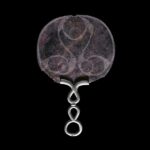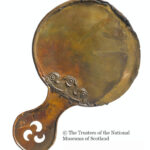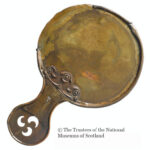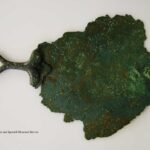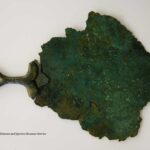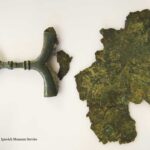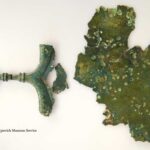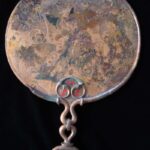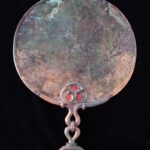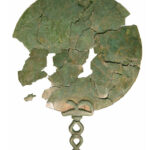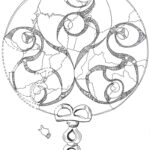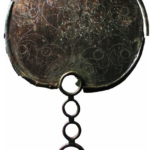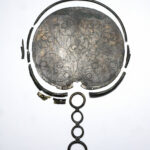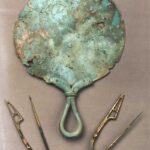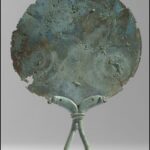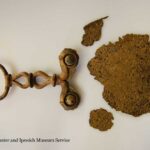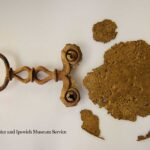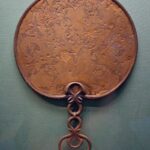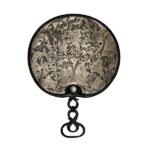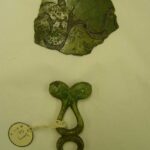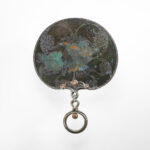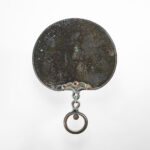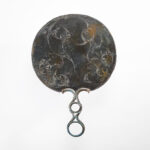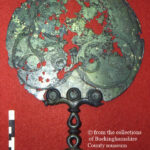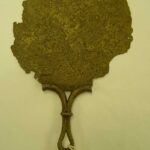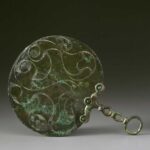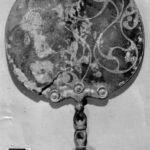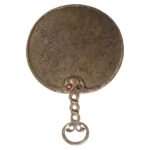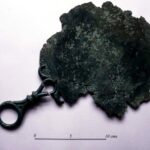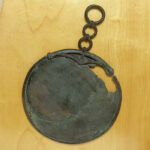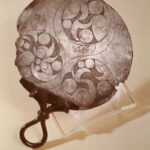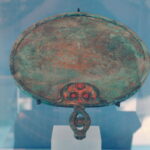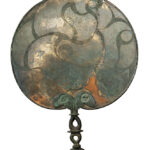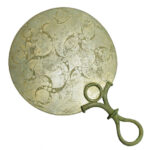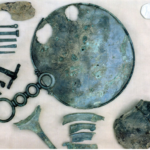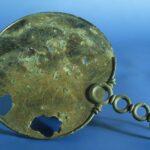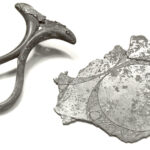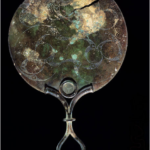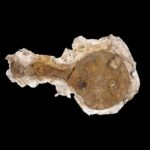Hand Mirrors Made by the Celtics (or “Keltik”)
from Approximately 300 B.C. to A.D.
Celtic (“Celtic” or “Keltik”) mirrors first came to my attention when a company I chair, financed an ancient coin and artifact dealers’ acquisition of two Celtic mirrors in 2004. When I first saw the mirrors, I found them intriguing, given in part that they were made about 2,000 years ago. Being a numismatist for 50 years, I also appreciated their metal expertise, engraving skills, and artistry.
The dealer sold the smaller of the two Dordrecht mirrors in 2006, and as part of the simplification of our business relationship I acquired the larger Dordrecht mirror in 2009. I launched this site as a public service in July 2009, in an effort to showcase basic information about the Celts, their culture and one of the most intriguing aspects of Celtic art-their mirrors.
Celtic mirrors were usually highly decorated and considered important examples of Iron Age art, created from approximately 300 B.C. to 70 A.D. The mirrors are made of bronze, iron, or a combination of both, and they are believed to have been the possessions of high-born women. Celtic mirrors, in reasonably complete condition, are quite rare as it seems there are perhaps 30 known.
Below you will find information on and pictures of the 28 mirrors that my office has located and documented. To stay focused, we have listed only the mirrors that exist and that seem “substantially intact,” which we define as complete mirrors or fragments with handles. Basis that definition, we have, for example, left off the three Mount Batten mirrors that were unfortunately destroyed during the World War II blitz of Plymouth, England.
This site also includes a chart of books published on the subject and on those knowledgeable about Celtic mirrors.
Given that my background has been in business, not academics, I built this site primarily for the general public. I hope this site will facilitate people interested in better understanding the fascinating yet little known Celtic culture and their wonderful mirrors… Steven C. Markoff.* (*Owner of the Dordrecht [Large] Celtic mirror.)
I. The Celts
“A branch of the Indo-European languages that (judging from inscriptions and place names) was spread widely over Europe in the pre-Christian era. The Celts are an indigenous people of central Europe with large numbers in the United Kingdom, in France, and in Ireland where they are in the majority
The Origins of the Celts:
“The Urnfield people were the largest population grouping in late Bronze Age Europe and were preeminent from c. 1200 BC until the emergence of the Celts in c. 600 BC. The spread of iron-working led to the development of the Hallstatt culture (c. 700 to 500 BC). The Hallstatt culture effectively held a frontier against incursions from the east by Thracian and Scythian ethnic tribesmen.
The subject of the succession of Halstatt culture by La Tène culture, the final stage of the Iron Age, and its gradual transformation into a characteristically Celtic culture is both complex and diverse, however the technologies, decorative practices and metal-working styles of the La Tène were to be very influential on the Celts. The La Tène style was highly derivative from the Greek, Etruscan and Scythian decorative styles with whom the La Tène settlers frequently traded.
Although they were for a long time the dominant people in central and Western Europe, the Celts in France, Britain and Spain were eventually conquered by the Romans, while elsewhere they were pushed further westwards by successive waves of Germanic invaders, who had themselves been evicted from the Indo-European homeland on the Southern Russian steppes by Mongols, Huns and Scythians. Thus, today the Celts are still the most westerly of European peoples, as they were in Herodotus’s time, since their modern descendants still inhabit the Atlantic coast. These include the Irish, Scots, Welsh, Breton, Manx and Cornish peoples and their descendants in the New World and other ex-colonies. (In fact, there are more people of Celtic descent in the United States alone than there are in all the Celtic countries combined!)
The Celts had a well-organized social system, which was harmonious with nature. They produced little in the way of literary output, preferring the bardic, oral, tradition. They were highly skilled in visual arts and produced a great deal of intricate and beautiful metalwork.”
-Source: “CELTIC,” websters-online-dictionary.org, 8/05/09
II. Celtic (Iron Age) mirrors
“Mirrors are some of the most well known objects from the British Iron Age. They are complicated objects made of bronze, iron, or a combination of bronze and iron components. They comprise a handle and a plate. The plate backs are sometimes decorated with complex designs. Mirrors have been found throughout the British Isles, most commonly in graves, and they date from around 300 BC – AD 70.
In the past mirrors have been interpreted as the possessions of high status women, although very little evidence has been provided to support this assumption. This project aims to test this hypothesis through a detailed examination of the way mirrors are made, how they were used and how they were deposited. The project also has wider implications for our understanding of the later British Iron Age. The manner in which mirrors are manufactured, decorated, and deposited, echoes many other contemporary Iron Age objects. Through an examination of Iron Age mirrors the project also aims then to comment upon late Iron Age society in Britain.”
-Source: Dr. Jody Joy, Phd. Project leader, Prehistory & Europe Dept., britishmuseum.org, 8/05/09
III. Celtic Art
“Celtic art (kel’tik, sel’–) . The earliest clearly Celtic style in art was developed in S Germany and E France by tribal artisans of the mid- to late 5th cent. B.C. With the dispersal of Celtic tribes during the next five centuries, their characteristically sophisticated designs were spread throughout Europe and the British Isles. Although some classical influence was evident in Celtic work, most of the complex, linear, highly ornamented pieces that survive reveal an inspiration of great originality and power.
Stylized and fantastic plant and animal forms, as well as strong, geometrical, intertwining patterns, decorated the surfaces of household and ritual vessels, weapons, and body ornaments. The principal materials used in the surviving pieces of metalwork, most numerous of the remains, are gold and bronze. Some painted ceramics and enamel work survive as well from the early period. Frequently, Greek-inspired arabesque motifs were modeled in low relief.
Artisans of the British Isles adapted Celtic design in the 3d cent. B.C., producing distinctive, vigorous works that soon owed little to Continental originals. Asymmetrical line engraving gained ascendancy in the 1st cent. B.C. for decorated weaponry and utensils.
Two hundred years later Roman influence had effectively overwhelmed Celtic styles, although typical motifs were retained well into the medieval period. Numerous first-rate examples of Celtic craftsmanship may be seen at the British Museum.”
-Source: “Celtic art,” thefreedictionary.com, 10/19/22
IV. Chart of 28 Celtic Mirrors
| # | Name, and Location A. | Description/Background/Acquisition Details B. | Photos C. |
|---|---|---|---|
| 1 | Aston mirror; British Museum, London, UK | Description: “Incomplete – missing rim. Diameter: 194.00mm Height: 19.4 cm The pattern on the back can be interpreted as an abstract or hidden face. The very fine lines of the symmetrical pattern were made with a graver, a tool with a hard, sharp edge. In parts of the pattern, lines were made at right angles to each other to make a prominent ‘basket-weave’ effect.” Background: “Iron Age, 50 BC – AD 50 This mirror was probably placed in a Late Iron Age cremation grave, but the grave was destroyed by ploughing. The main part of the mirror was found by a farmer, the handle found the following year.” -Source: British Museum, 8/12/09 PDF Excavated/Findspot: Europe, British Isles, England, Hertfordshire, Aston (Hertfordshire). Acquisition Details: “The Aston mirror has the accession number 1979,1002.1 and 1981,0504.1 because the mirror plate and the handle were found separately in 1979 and 1981.” Gift of W.S. Jefferies For more information about the Aston mirror click here. PDF | |
| 2 | Balmaclellan mirror; National Museum of Antiquities, Edinburgh, UK | Description: Reconstructed from fragments. “Bronze Circular Mirror, measuring 13 inclies in length including handle, with embossed ornaments on each side, and handle ornamented with triple perforation; a Crescent-shaped Plate of Bronze, ornamented with incised scroll patterns its greatest diameter measures 13 inches, and across the plate 2 inches ; also various portions of triangularly-shaped Bronze Plates, with two ornamented studs or buttons, and Bronze Belts with pieces of coarse linen cloth found intrenching a moss in the parish of Balmaclellan, New Galloway.” -Source: Archaeology Data Service, ads.ahds.ac.uk, 8/21/09 Background: 1st century BC — mid 1st century AD Southwest Scotland. “Found in the parish of G-irthon, Galloway. A bog was being drained for agricultural purposes, and the workman in cutting the drains, which are from 2-J to 3 feet deep, came upon a peculiar-shaped stone, which he threw aside and afterwards took home with him. Sometime after the drains were cut, the farmer himself was clearing them out with a hoe, preparatory to setting the stones, here largely used instead of tiles; and, close by where the quern was found, he came upon the bronze circular-shaped mirror, with the crescent-shaped ornament.” -Source: Archaeology Data Service, ads.ahds.ac.uk, 8/21/09 National Museums Scotland Acquisition Details: ? |
|
| 3 | Billericay mirror (one); Colchester Museum, Colchester, UK | Description: Fragment – Incomplete. Background: 1st century BC — mid 1st century AD Found circa 1860, probably in a cremation burial, Essex, UK. Acquisition Details: ? |
|
| 4 | Billericay mirror (two); Colchester Museum, Colchester, UK | Description: Fragment with handle. Background: 1st century BC — mid 1st century AD Found circa 1860, probably in a cremation burial, Essex, UK. Acquisition Details: ? |
|
| 5 | Birdlip mirror; Gloucester City Museum, Gloucester, UK | Description: Female burial, Birdlip. Bronze. Intact except for 33% of rim and with heavily pitted surfaces. Height with handle: 381 mm Height plate: 28.7 cm Width plate: 265 mm Length: 38.7cm “The Birdlip mirror design on the back of the bronze mirror is etched in to the metal. The pattern is composed of interlocking triskeles which end in groups of two or three flourishes. The handle of the mirror consists of a series of interlocking loops, the final loop, encloses another smaller circle of metal. Red enamel dots can be found on this circle, as well as on the top of the handle, where the handle meets the body of the mirror. This area could be defined as a pelta, or a small mushroom shape, similar in form to the Egyptian lotus bud.” -Source: University of North Carolina at Chapel Hill, unc.edu, 8/14/09 “It is one of the finest items of British celtic art to survive today, and perhaps the finest example housed outside a national museum.” -Source: "Birdlip Grave Group Mirror Construction," Gloucester City Council, gloucester.gov.uk, 8/14/09 Background: 1st century BC — mid 1st century AD Discovered in 1879, found in Female burial, Birdlip Gloucestershire. “Buried with a group of iron-age treasures around AD 50 along with the owner. In 1879 workmen discovered three skeletons in a quarry between Crickley and Birdlip overlooking the Vale of Gloucester. With the bones were some amazing Iron Age artifacts. The most important object is a handheld mirror of bronze.” -Source: "The Birdlip Grave Group," Gloucester City Council, gloucester.gov.uk, 8/14/09 Acquisition Details: Purchased from the finder by a local business man. Presented to the museum in 1880. For more information about the Birdlip mirror, contact the Archeology Curator, Gloucester Museums Service, Regeneration (per email 8/3/2009) (per an email of 5/5/2020 – David Rice has been retired from the Gloucester city museum for some years and there are no updates on a replacement.) |
|
| 6 | Bromham mirror; Verulamium Museum, Hertfordshire, UK | Description: Broken & Incomplete. Height: 25.5 cm Width: 21.5 cm “A fragmentary and incomplete bronze mirror of late Iron Age date. It is suggested that the piece dates from the 1st century BC, since it lacks the kidney-shaped plate and binding strip of later examples. Sixteen fragments of the object were recovered from the topsoil and subsoil and represent approximately three quarters of the original artefact. These pieces were spread across an area of approximately 300 square metres, probably as a result of deep ploughing. Overall, the reconstructed object is 255mm high and weighs 265.5g. The plate is oval and measures up to 215mm wide by 190mm high and 1mm thick. The reverse has an engraved symmetrical pattern. This is comprised of a series of swirling lines and circles forming a triple lobe ‘lyre’ arrangement typical of mirrors of this period. The outline pattern has basketry infill made up of an irregular series of blocks of decoration containing either parallel horizontal or vertical incisions. These are broken up with occasional insertions of circles or petal-shaped incisions. The design is surrounded by large amounts of blank space and is stylistically similar to examples from Dorton in Buckinghamshire, Bramley near Silchester, Rivenhall, Old Warden (Bedfordshire) and Great Chesterford (see references below). The outer edge of the plate is marked by a narrow raised rim. The reverse is plain. It has a deep green patina. The handle is of cast bronze. The top of the handle consists of a pair of double semi-circular openwork attachments. These are separated by a transverse slot into which the mirror plate is fitted. Two copper-alloy rivets of circular section, located at the top of the semi-circular attachments, serve to join the plate to the handle. This attachment is damaged and incomplete on the reverse. It gives way below to a circular moulding which, in turn, gives way to the rest of the handle (now detached). This remaining portion of the handle is comprised of two bronze loops separated by a circular moulding. A further moulding sits between the base of the lower loop and an attached fragment of what was presumably a base ring (now missing). The surface of the handle is heavily pitted.” – Source: Julian Watters, Finds Liaison Officer for Hertfordshire and Bedfordshire, 9/11/09 Background: 1st century BC — mid 1st century AD Found October 2004 in Bromham, Bedfordshire, with metal detector. “At a rally of the Weekend Wanderers Metal Detecting Club in Bromham, Bedfordshire in March 2004, Mr. Clifford discovered a fragment of rare decorated bronze mirror of late Iron Age date. Such mirrors are unusual finds and excavated examples are generally found in female graves. Over the course of the day, fifteen more fragments of the mirror were recovered by club members. The locations of the heavily plough-damaged artifacts were recorded by Julian Watters using a handheld GPS device. Phil Carter (Verulamium Museum) is currently working on the reconstruction of the mirror.” -Source: British Museum, finds.org.uk, 8/18/09 PDF Acquisition Details Verulamium Museum, Bedfordshire, England. For more information about the Bromham mirror, click here. PDF |
|
| 7 | Chettle Park hoard; British Museum, London, UK | Description: Dimensions: 23.5 x 21cm “This mirror is decorated with an exquisite geometric La Tène design. The decoration is the most beautifully executed example known to date (60 mirrors of this period are known from Britain). The Chettle mirror complements other mirrors in the British Museum’s collections, particularly Desborough and Holcombe but is of greater artistic note. The museum is embarking on the first systematic full-scale study of Iron Age mirrors in Britain for over a century. The mirror forms part of a larger rare burial hoard and the museum hopes to display the hoard together with a focus on the mirror and its uniqueness and skill of decoration.” – Source: Mirror from the Chettle Park hoard, artfund.org, 8/27/09 PDF Background: Iron Age 1st century BC — mid 1st century AD “Found by a metal detectorist in Chettle Park, Dorset as part of an assemblage of bronze and glass objects by metal detectorists in August 2003.” Acquisition Details: Grant Paid: £18,000 (Total: £18,000) ArtFunded in: 2009 Vendor: Department for Culture, Media and Sport For more information on the Chettle Park hoard mirror, click here. PDF |
|
| 8 | Chilham-Castle mirror; Museums, Libraries and Archives Council, London, UK | Description: British Iron Age Length: 188 mm Plate measures: 126 mm x 136 mm “The elegant copper-alloy mirror dates back to 75 BC, around a century before the Roman conquest. It is approximately 19 cm high by 13 cm wide, and is made up of a roughly circular plate delicately engraved with Celtic ornament, and a looped handle. The reflective surface would originally have been a shiny gold colour, suggestive of sunlight.” Background: circa 75 — 25 BC The mirror was found in a high-status grave, and may have had a religious, as well as a utilitarian function. “The mirror, together with the brooches, was discovered by a metal detectorist in a shallow cremation grave at Chilham Castle in Kent in 1993. As the only Iron Age mirror to have been discovered in Kent, only 17 complete decorated mirrors dating from the Iron Age have been found in Britain. This is one of the earliest, and is especially significant because it comes from a known context which was subsequently investigated by archaeologists using modern excavation techniques.” -Source: mla.gov.uk, 8/17/09 Acquisition Details: ? |
|
| 9 | Colchester Lexden Mirror; Colchester Museum, Essex, UK | Description: Reconstructed from fragments. Background: 1st century BC — mid 1st century AD Found in a burial at Lexden Grange, in 1904 (probably from the period of Cunobelin, c. 10 — 25 AD), Colchester, Essex. Acquisition Details: ? |
|
| 10 | Desborough mirror; British Museum, London, UK | Description: “From Desborough, Northamptonshire, England.Decorated bronze mirror—a highlight of British La Tène / Celtic Art. Intact – but with somewhat pitted surfaces. Diameter: 20 cm Length: 35.000 cm The decoration on the back of the mirror and pattern is very complex: a clover-leaf pattern is symmetrically repeated on the left- and right-hand side of the mirror. The pattern may have been laid out using a compass. Recent archaeologists have suggested that mirrors should be seen as symbols of female status and power, making as significant a statement for women as swords did for men.” -Source: British Museum, britishmuseum.org, 8/12/09 Background: Iron Age, 50 BC — AD 50 Found during ironstone digging in 1908 near Desborough village, Northants. Acquisition Details: Total cost in 1924 was £225, paid by a grant from the Art Fund. (A non-government British charity that relies on membership subscriptions and public donations.) |
|
| 11 | Disney mirror (fragment); British Museum, London, UK | Description: Fragment with handle. Background: 1st century BC — mid 1st century AD Acquisition Details: ? | |
| 12 | Dordrecht [Large] mirror; Santa Monica, California, USA | Description: Some corrosion that has been stabilized. Diameter: 26.5 cm “Restoration work done in 2004: Lightly cleaned the heavier encrustations from the disc so as to reveal all design elements and stabilized any remaining copper deposits; Secured the loose beaded borders to the disk; Fabricated a third loop of the broken handle, that which is closest to the disc itself, and permanently reattached the handle to the disc.” Background: Said to have been found in the vicinity of Dordrecht, Netherlands circa 1967. Acquisition Details: Last purchased in 2004. |
|
| 13 | Dordrecht [Small] mirror; Privately held, unknown location. | Description: Intact. Diameter: 21.5 cm Background: 1st century BC — mid 1st century AD Said to have been found in the vicinety of Dordrecht, Netherlands, circa 1967. Acquisition Details: Purchased from Christie’s December 7, 2011 Auction sale for $170,500; Provenance: Private Collection, the Netherlands, 1960’s. | |
| 14 | Dorton Mirror; Buckinghamshire County Museum, Aylesbury, UK | Description: Reconstructed from fragments. Height: 30.2 cm Background: 1st century BC — mid 1st century AD Bucks, England. “Welwyn style burials have been found at Dorton (Farley, 1983) and possibly Aston Clinton (Bucks SMR 0043); the former producing a fine Late La Tene mirror. None of these burials need be earlier than the early-mid 1st century AD and some are likely to be post-conquest. They reflect the county’s incorporation into the emerging Catuvellaunian “kingdom” – the absence of such burials (so far at least) from the south of the county may be significant, perhaps reflecting a shifting frontier with the Atrebates (Cunliffe, 1991, 151). … Late La Tene metalwork has been found in the form of a sword from the Thames at Amerden (nr Taplow) (Clinch, 1905, 186) and a mirror from the Welwyn style burial at Dorton (Farley, 1983).” -Source: buckscc.gov.uk, 8/17/09 Acquisition Details: Accession number AYBCM : 1977.574.1 | |
| 15 | Gibbs mirror; British Museum, London, UK | Description: Fragment – Incomplete. Dimensions: Length: 200 mm Diameter: 140 mm (plate) Copper-alloy mirror comprising a sheet metal plate and a cast handle. The plate was originally inscribed with decoration. This is no longer visible but at some point in the past the decoration outline has been traced onto the plate. The plate is damaged at the edges but would originally have been circular. The terminal loop of the handle is missing. The attachment of the handle and plate is secured with two rivets one on each arm of the handle. Background: Kent Acquisition Details: Accession no. 1296.’70. Bequeathed by William Gibbs (1790-1875) of Tyntesfield. Acquisition date 1870. | |
| 16 | Great Chesterford mirror; Cambridge Museum, Cambridge, UK | Description: Broken. Height: 23.5 cm “This Celtic bronze mirror, much like the Old Warden Mirror from Bedfordshire, contains a design based on three-sided voids, rather than lobe patterns. Six matted shapes are located around the perimeter of the mirror. These shapes appear in different form, yet all are connected by the interwoven basket-hatching.” Background: 1st century BC — mid 1st century AD Found circa 1959 in a female burial at Chesterford, Essex, UK. -Source: University of North Carolina at Chapel Hill, unc.edu, 8/17/09 Acquisition Details: ? |
|
| 17 | Holcombe mirror; British Museum, London, UK | Description: Intact – but with pitted surfaces. Dimensions: 33×27 cm Length: 372.000 mm Width: 260.000 mm Weight: 800.000 g “The mirror is made from bronze and is decorated with a symmetrical ‘Celtic’ or La Tene design. The complicated design is now difficult to see because it was badly corroded by being buried for 2000 years at the bottom of a pit. In fact, when the mirror was first found, no one could see any decoration on the mirror plate at all. It was only after it was carefully cleaned by conservators at the British Museum that the design could be made out.” Background: “Iron Age, Bronze, about AD 30 — 70 Found under the Roman villa buildings at Holcombe, towards the South Dorset-Devon border. Excavated by Lady Fox around 1973. In 1967 Devon Archaeological Society heard that a Roman mosaic pavement had been found by a farmer near Uplyme in East Devon. The Society started archaeological excavations at the site in 1969 and discovered a Roman villa. In 1970 a volunteer on the dig, Nicholas Riall, was excavating a pit found under the floor of one of the rooms in the villa. In the bottom of the pit he found an Iron Age bronze mirror, which was placed there during the first century AD.” -Source: British Museum, britishmuseum.org, 8/12/09 Acquisition Details: ? |
|
| 18 | Latchmere Green mirror; Andover Museum, Hampshire, UK | Description: The Latchmere Green mirror is currently on display at the Andover Museum. More information about the Latchmere Green mirror can be found in the Proceedings of the Prehistoric Society – Volume 64, 1998, A Late Iron Age Mirror Burial from Latchmere Green, near Silchester, Hampshire By Michael Fulford and John Creighton – Source: David Allen, Hampshire County Council, October 2009. Background: This paper describes the find, in 1994, of an isolated Late Iron Age burial near the oppidum of Calleva Atrebatum (Silchester). The burial consisted of the cremated remains of an adult of about 30 years together with a child of under 5 years, buried in a pottery jar of a type familiar from Calleva. The jar also contained cremated pig bone. The burial was accompanied by fragments of at least two fibulae and a very finely decorated bronze mirror, for which no close parallels are known. The burial dates to the 1st century BC, possibly before 50 BC. – Source: David Allen, Hampshire County Council, October 2009. Acquisition Details: ? | |
| 19 | Llechwedd-du Bach mirror; National Museums & Galleries of Wales, UK | Description: Incomplete. “Bronze circular mirror with a handle of Late Celtic design. The triple loops of the handle, which is of cast bronze, are linked by beaded collars.” -Source: gtj.org.uk, 8/21/09 Background: Merioneth, Wales “Found in the mid-19th century with a tinned bronze plate. Both items may have come originally from a woman’s burial. Roman mirrors served exactly the same purpose of personal vanity as they do today. At least one side of the mirror plate would have been silvered or tinned to achieve a reflective surface.” Acquisition Details: Item reference 25.73/1 This item comes from museumwales.ac.uk. If you would like to see the original item, or require information regarding copyright, please contact the repository/contributor named above. | |
| 20 | Mayer mirror; World Museum, Liverpool, UK | Description: Incomplete – missing outer elements and rim. Bronze. Height: 22.5 cm Also called the Engraved Mirror, Southeast England. City Museum, Liverpool Background: 1st century BC — mid 1st century AD “This flat bronze mirror displays a variety of sub-triangular and curvilinear forms with lobe patterns accenting the design. The decoration consists of three circles, or roundels, in which three-sided voids are carefully situated. The unprovenanced Mayer mirror, possibly one of the earliest, shows a simpler version of the lyre, a design executed with consummately economical craftsmanship (Megaw 30). Even though some damage has affected this mirror, the majority of the mirror has been well preserved, especially considering the age of such an object. The Mayer Mirror has a basic loop handle. A small iron loop is ‘tied’ around the middle of the loop creating a teardrop shape, a shape in which one could easily hang the mirror on the wall.” -Source: University of North Carolina at Chapel Hill, unc.edu, 8/14/09 Acquisition Details: Accession no. M6395, donated to the museum in 1867 by the antiquarian Joseph Mayer, (Dr. Ashley Cooke, 6-15-09). | |
| 21 | Nijmegen mirror; Valkhof Museum, Nijmegen, Netherlands | Description: Incomplete. Diameter: 29.3 cm Background: "Found in a grave of the second century BC, Nijmegen, Netherlands. Nijmegen, a city in the Netherlands, where several Roman settlements have been discovered. Made in England between 50 BCE and 50 CE, this mirror was taken to Germania Inferior by a Batavian soldier serving in Britain, and buried in a second-century tomb in Nijmegen." -Source: Livius.org, livius.org, 8/18/09 Acquisition Details: ? | |
| 22 | Old Warden mirror; Bedford Museum, Bedfordshire, UK | Description: Bronze. Intact. Height: 28.3 cm “Three-sided voids primarily dominate the Old Warden Mirror, much like the Great Chesterford Mirror. Four open roundels are asymmetrically situated throughout the design. Much of Celtic Art is ornamental, thus, it does nothing more than serve an aesthetic purpose. The decoration on the mirrors is simply nonfunctional. -Source: University of North Carolina at Chapel Hill, unc.edu, 8/14/09 Background: 1st century BC — mid 1st century AD “Information you have requested can be found in a paper published by Mansel Spratling in 1970. The paper 'The Late Pre-Roman Iron Age Bronze mirror from Old Warden' was published in the Bedfordshire Archaeological Journal, Volume 5, 1970, pages 9-16, plates 1, 2 and 3. The volume is edited by DH Kennett and is published by The Bedfordshire Archaeological Council.” – Source: Liz Pieksma, Bedford Museum, October, 2009. Acquisition Details: ? | |
| 23 | Oxfordshire mirror, Privately-held, unknown location | Description: Dimensions: Height: 10 3/4 inches Diameter of Disc: 7 1/4 inches Length of handle: 5 inches Width of handle where it inserts onto disc: 2 3/4 inches The Mirror is made of copper-alloy, and consists of two elements – the Disc was found intact and the handle was in two pieces. It is in very good condition and its complex and beautiful decoration is an unusual and innovative example of Celtic ‘mirror-style’ art’. This one is of an early type, dating to the first century BC, and is decorated with a highly unusual and beautiful curvilinear, La Tène style pattern which has been inscribed into the back by a craftsman who must have been extraordinarily skilled. Unlike the Desborough mirror that was probably drawn with a compass, the design on the Oxfordshire mirror may have been drawn freehand and is most similar to the Pegsdon/Shillington Mirror. Background: 75 BC This mirror was discovered by a metal detectorist in the Didcot area circa 2006 in Oxfordshire, U.K., and the finder reported it to St Albans Finds Liaison Officer. Mirrors from southern England, like this specimen are highly significant for our understanding of the later Iron Age, and offer important insights into the social changes which occurred in the century before the Roman conquest in AD 43. They are potentially objects of high status, and their manufacture and usage, alongside toilet implements such as tweezers and grinders for cosmetics, demonstrate the importance of personal appearance as a means of social expression during the later Iron Age. Oxfordshire has many Iron Age sites such as Badbury Rings, Uffington Castle and the newly excavated Great Western Park site in Didcot. Acquisition Details: “The mirror was subsequently taken by the two (of the finders) to St. Albans Museum where it was professionally restored and conserved by archaeologists.” The Oxfordshire Museum commenced a fundraiser to purchase the mirror, and successfully raised 33,000 English pound (about USD 51,500), to purchase the mirror from a private collector, who purchased the mirror from the finder, in 2007. For Relevant Literature please consult: Atlas of The Celts. By Barry Raftery, University College Dublin. ISBN: 0-540-08153-1 – Source: bidancient.com, 8/27/09 | |
| 24 | Portesham mirror; Dorset County Museum, Dorset, UK | Description: Bronze. Intact. Dimensions: 31 x 19 cm “Composed of cast and hammered bronze parts with engraved and chased design on the mirror back. Probably individually composed for the owner and suggests her high social status.” -Source: "The Portesham mirror," artfund.org, 8/18/09 PDF Background: 1st century BC — mid 1st century AD “Excavated at Portesham, Dorset, October 1994.” -Source: "The Portesham mirror," artfund.org, 8/18/09 PDF Acquisition Details: Total cost in 1995 was £75,000, £18,500 of which was provided by a grant from the Art Fund. (A non-government British charity that relies on membership subscriptions and public donations.) Vendor: Robert Fraser and John Rule - Source: "The Portesham mirror," artfund.org, 8/18/09 PDF For more details about the Portesham Mirror, artfund.org, click here, 8/18/09. PDF |
|
| 25 | Rivenhall mirror (fragment); Chelmsford Museum, Chelmsford, UK | Description: Iron Age Fragment with handle. Dimensions: Height: 276 mm Width: 200 mm The Rivenhall mirror is currently on display at the Chelmsford Museum. Background: “1st century BC — mid 1st century AD Found in 1848 near the church ‘beside a passage of Roman pavement’ in Essex.” Acquisition Details: “Accession no. B18303. Donated by the Chelmsford Philosophical Society. For relevant literature please consult: [Citation] Fox, Sir Cyril, ARCHAEOLOGIA. 61:337, Figure 5; Rodwell & Rodwell, Rivenhall Investigations II, CBA. 80: 29-33, Figure 12-3 – Plate 23b.” – Source: Anne Lutyens-Humfrey, Chelmsford Museums, August 2009. | |
| 26 | Shillington mirror; Wardown Park Museum, Luton, UK | Description: Bronze (mirror) & Silver (brooch) Broken. Diameter: 20 cm “A mirror decorated in a swirling early Celtic style using engraved circles, ovals and arches, emphasised by a fine basket weave in fill. The mirror is round with a relatively simple loop handle which is typical of its time. The brooch was found in close proximity to the mirror together with some pottery shards.” Background: 70 — 20 BC Found by metal detectorists at a farm in Shillington, Bedfordshire. -Source: "Shillington mirror & brooch," artfund.org, 8/14/09 PDF Acquisition Details: ArtFunded in: 2002 Vendor: Department for Culture, Media and Sport. Total cost in 2002 was £35,000, £7,000 of which was paid by a grant from the Art Fund. (A non-government British charity that relies on membership subscriptions and public donations.) For more information about the Shillington mirror, click here. PDF | |
| 27 | Trelan Bahow (aka St. Keverne) mirror; British Museum, London, UK | Description: Incomplete with pitted surfaces. Height: 22 cm Diameter: 16.500 cm “Decorated copper alloy mirror, with engraved La Tène decoratation on back and cast handle. The front of the mirror is much pitted with corrosion. The back is decorated in a relatively simple style arranged within two circular areas. There is a border of hatched triangles. The handle has a loop which is contained within a Y-shape beyond a double moulding.” Background: “Period/Culture: La Tène Iron Age 100 — 1 BC Found in one of several graves in a field called Bahow Trelan farm on southern edge of Goonhilly Down, in 1833. In 1833 a new road was being made across the Trelan estate in western Cornwall when the workmen found a number of Iron Age burials. This mirror was discovered in one of the graves found by the workmen in 1833. There were other objects in the grave including two brooches, two glass beads and two rings or bracelets. No scientific examination was carried out on the skeleton to establish the dead person’s sex and it was assumed that a mirror and jewellery must belong to a woman.” -Source: British Museum, 8/12/09 PDF Acquisition Details: Gift of J.J. Rogers, with the sanction of T.H. Edwards For more information about the Trelan Bahow mirror, click here. PDF |
|
| 28 | Wetwang mirror, British Museum, London, UK | Description: Iron Age circa 300 BC East Yorkshire, England This iron mirror was found resting against the woman’s ankles in the grave. Careful cleaning has revealed well over a hundred tiny blue glass beads, so small that they could only have been threaded on to horse hairs, as well as metal and coral beads. Were the beads from a tassel at the end of the handle, or perhaps from a bag in which the mirror was kept? As the mirror decayed, impressions formed in the rust of some cloth where it touched the mirror. Why was the mirror in the grave? Was it an important personal object that the woman used in life? Did the mirror have a special religious or magical role?. These are questions that we may never be able to fully answer. – Source: British Museum, britishmuseum.org, 10/25/09 Background: “Found in 2001 in a Chariot Grave near Wetwang in East Yorkshire, England by Adrian Havercroft and his team from Guildhouse Consultancy. The body in the grave at Wetwang was that of a woman. What was special was the richness of the woman’s grave, the decoration in red coral of so many items, and her mirror. This was found lying over her lower leg bones; it was made of iron, and upon being safely lifted from the grave, removed to the laboratory for final excavation and conserving. During this process it was discovered that there was also a mass of tiny blue glass beads, only a few millimetres in diameter, together with metal, and possibly coral beads and spacers located next to the handle of the mirror.” -Source: yorkshirehistory.com, 8/14/09 Acquisition Details: ? |
V. People with expertise on Celtic Mirrors/Art
| # | Name, Education & Position A. | Expertise/Publications/Articles on Celtic Mirrors B. | Contact Info C. |
|---|---|---|---|
| 1 | Ashworth, Helen | Expertise: Specialist in late Iron Age & Roman Pottery. Publications/Articles: – Ms. Ashworth’s involvment with the Article The Iron Age Mirror Burial at Pegsdon Shillington Bedfordshire: An Interim Account Antiquaries Journal, Vol. 87 (2007), was restricted to the group of pottery sherds found in association with the mirror. | The Heritage Network Ltd; Email: hma(at)heritagenetwork.co.uk www.heritagenetwork.co.uk 11 Furmston Court Icknield Way Letchworth SG6 1UJ, UK Phone: 01462 685991 |
| 2 | Burleigh, Gil(bert); Freelance Archeaological Consultant – 8/24/09 | Expertise: Publications/Articles: – Author of the Article: The Iron Age Mirror Burial at Pegsdon Shillington Bedfordshire: An Interim Account Antiquaries Journal, Vol. 87 (2007) | Email: gilburleigh(at)aol.com 10 Cromwell Way, Pirton, Hitchin SG5 3RD, UK |
| 3 | Drummond, Linda; Departmental Administrator, Department of Archaeology, National Museums Scotland – 8/24/09 | Expertise: Publications/Articles: | Email: l.drummond(at)nms.ac.uk; National Museums Scotland, Chambers Street Edinburg, EH1 1JF, UK Phone: 0131 247 4050 |
| 4 | Follett, Barbara; Minister of Culture, Creative Industires & Tourism, UK, British Parliament – 8/24/09 | Expertise: In March, 2009, Barbara Follett placed a temporary export bar on a rare Iron Age Celtic mirror found in Chilham Castle, Kent, as a historically significant object to the United Kingdom. A report on the issue can be found by this link. Publications/Articles: | Barbara Follett, MP House of commons Westminster, London, SW1A0AA, UK Phone: 01438 222 800/020 7219 2649 |
| 5 | Freeman, Robert; Founder, Freeman and Sear – 8/24/09 | Expertise: Publications/Articles: | Email: info(at)freemanandsear.com P.O. Box 641352 Los Angeles, CA 90064-6352 Phone: (310) 450-9755 |
| 6 | Gentil, Paula; Curator of Archaeology, Hull and East Riding Museum c/o Ferens Art Gallery – 8/24/09 | Expertise: The Hull and East Riding Museum hold two Iron Age mirrors both of which are made of iron and found in high-status female burials. 1) Garton Slack VII, Barrow 2, Central Grove-found during excavations by T.C.M. Brewster in 1970 and 2) Wetwang Slack, Chariot Burial 2–found during excavations by Humberside Archaeology Unit in 1984. Publications/Articles: Ian Stead (1979) Arras Culture, pp. 81-83 gives more information on the significance of the iron mirrors from Yorkshire and provides some parallels. | Email: paula.gentil(at)hullcc.gov.uk hullcc.gov.uk Queen Victoria Square Hull HU1 3RA, UK Phone: 01482 616442 |
| 7 | Gwilt, Adam; Curator of the Bronze & Iron Age Collections, Department of Archaeology & Numismatics, Amgueddfa Cymru – National Museum Wales, UK – 8/24/09 | Expertise: Publications/Articles: | Email: adam.gwilt(at)museumwales.ac.uk museumwales.ac.uk National Museum Cardiff Cathays Park Cardiff, CF10 3NP, UK Phone: 44(0)29 2057 3374 |
| 8 | Hayton, Richard; Designer, Yorkshirehistory.com – 8/24/09 | Expertise: Publications/Articles: – Web Article on Iron Age Chariot Burials (2005) | Email: richard(at)yorkshirehistory.com |
| 9 | Hill, Dr. J.D.; Keeper of Iron Age, The British Museum, London, UK – 8/24/09 | Expertise: Publications/Articles: | Email: collectionenquiries(at)britishmuseum.org www.britishmuseum.org The British Museum Great Russell Street London, WC1 3DG Phone: 44 (0) 207323 8838 |
| 10 | Joy, Dr. Jody; Former curator of Iron Age Collections Department of Prehistory and Europe, The British Museum, London, UK – 8/24/09 (New curator – Julia Farley) (Dr. Jody Joy is Senior Curator (Archaeology), Museum of Archaeology and Anthropology at Cambridge as of 6/2022 – jpj32 [at] cam.ac.uk) | Expertise: Publications/Articles: | Great Russell Street London. WC1B 3DG, UK Phone: 207 3238292 |
| 11 | Little, Charles; Curator, Department of Medieval Art and The Cloisters, The Metropolitan Museum of Art, NYC, USA – 8/24/09 | Expertise: Publications/Articles: | Email: charles.little(at)metmuseum.org The Metropolitan Museum of Art, 1000 Fifth Avenue New York, NY 10028-0198 Phone: 212-650-2624 |
| 12 | Medlycott, Maria; – 9/08/09 | Expertise: Publications/Articles: | Email: Maria.Medlycott(at)essex.gov.uk |
| 13 | Megaw, Ruth; Senior Research Fellow, Flinders University – 8/24/09 | Expertise: Publications/Articles: – Book: Celtic Art: From Its Beginnings to the Book of Kelts (2001) | Email: Ruth.Megaw(at)flinders.edu.au |
| 14 | Megaw, Dr. Vincent; Emeritus Professor J.V.S. Megaw Department of Archaeology Flinders University – 8/24/09 | Expertise: Publications/Articles: – Article: The Iron Age Mirror Burial at Pegsdon Shillington Bedfordshire: An Interim Account Antiquaries Journal, Vol. 87 (2007); – Book: Celtic Art: From Its Beginnings to the Book of Kelts (2001) | Email: Vincent.Megaw(at)flinders.edu.au Flinders University GPO Box 2100 Adelaide SA 5001, Australia |
| 15 | Murden, Jon; Director, Dorset County Museum, Dorchester, UK – 8/24/09 | Expertise: The Portesham Mirror is housed here. Publications/Articles: | Email: secretary(at)dorsetcountymuseum.org, Email: enquiries(at)dorsetcountymuseum.org; Dorset County Museum, High West Street, Dorchester, DT1 1XA, UK Phone: 01305262735 |
| 16 | Muskett, Dr. Georgina; Curator of Antiquities (Classical & European), World Museum Liverpool, Liverpool, UK – 8/24/09 | Expertise: The Mayor Mirror is housed here. Publications/Articles: | liverpoolmuseums.org.uk/wml/ World Museum Liverpool, William Brown Street, Liverpool, L3 8EN, UK Phone: 44 (0) 151 478 4393 |
| 17 | Parfitt, Keith; Field Director, Canterbury Archaeological Trust Ltd. – 8/24/09 | Expertise: Publications/Articles: – The Anglo-Saxon Cemetery on Mill Hill, Deal, Kent (1998); – Iron Age Burials from Mill Hill, Deal (1995); – Ringlemere, Precious Cups and the Beginning of the Channel Bronze Age (2006); – Tornwall Street, Dover: Excavations 1996 (2006); – Ringwould: A Small Village in Kent (1999) | Email: museumenquiries(at)dover.gov.uk |
| 18 | Perrett, Tom; Head of Collections and Exhibitions, Bedford Museum, Bedfordshire, UK – 8/24/09 | Expertise: The Old Warden Mirror is housed here. Publications/Articles: | Email: tperrett(at)bedford.gov.uk Bedford Museum, Castle Lane, Bedfordshire, MK40 3XD, UK Phone: 01234 353323 |
| 19 | Raftery, Barry; (deceased per an email of 5/5/2020) Associate Professor of Celtic Archaeology, University College Dublin – 8/24/09 | Expertise: Publications/Articles: – Trackway Excavations: 3 (1998); – Trackways Through Time: Archaeological Investigations on Irish Bog Roads, 1985 – 1989 (1990); – Pagan Celtic Ireland: The Enigma of the British Iron Age (1998); – Philip’s Atlas of the Celts (2001) | |
| 20 | Rice, David; Former Archaeology Curator, Gloucester Museums Service Regeneration – 8/24/09 (Former contact person for the Birdlip mirror, May, 2020) | Expertise: ? Publications/Articles: ? | Email: city.museum(at)gloucester.gov.uk Gloucester City Museum & Art Gallery, Brunswick Road, Gloucester GL1 1HP, UK Phone: (01452) 396131 |
| 21 | Rigby, Valery; Department of Prehistory and Europe, British Museum, London, UK – 8/24/09 | Expertise: ? Publications/Articles: – Britain and the Celtic Iron Age (1997) | The British Museum Great Russell Street London, UK WC1B 3DG Phone: 44 (0) 20 7323 8838 |
| 22 | Email: paul.sealey(at)colchester.gov.uk Museum Resource Centre 14 Ryegate Road Colchester Essex CO1 1YG, UKPhone: 01206-282932 (main office) Phone: 01206-506961 (direct) e-mail: | Expertise: The museum houses the Colchester Lexden mirror, and two of the three mirrors from Billericay. Publications/Articles: Sealey, P.R., 2006. ‘Two new decorated Iron Age mirror finds from Essex’, in P.J. Ottaway (ed.), A Victory Celebration: Papers on the Archaeology of Colchester and Late Iron Age-Roman Britain Presented to Philip Crummy (Colchester),11-18 Sealey, P.R., 2007. A Late Iron Age Warrior Burial from Kelvedon, Essex (East Anglian Archaeology Report 118) (Colchester) [Pages 12-13 discuss the relationship between mirror handles and tankard handles] | Email: paul.sealey(at)colchester.gov.uk Museum Resource Centre 14 Ryegate Road Colchester Essex CO1 1YG, UKPhone: 01206-282932 (main office) Phone: 01206-506961 (direct) e-mail: |
| 23 | Silvia, Vallejo; Freeman and Sear – 8/24/09 | Expertise: Publications/Articles: – A Compendium of Iron Age Celtic Mirrors for F & S, 2004 | ? |
| 24 | Sprating, Mansel | Expertise: Publications/Articles: – Article: The Iron Age Mirror Burial at Pegsdon Shillington Bedfordshire: An Interim Account Antiquaries Journal, Vol. 87 (2007) | 73 Coolidge Gardens, Cottenham, Cambridge, CB24 8RQ, UK |
| 25 | Stead, Ian M.; Deputy Keeper (Retired), Department of Prehistoric and Romano-British Antiquities, The British Museum – 8/24/09 | Expertise: Publications/Articles: – Celtic Art (1997); – British Iron Age Swords and Scabbards (2006); – The Gauls: Celtic Antiques from France (1981); – Celtic Art in Britain Before the Roman Conquest (1985) | Contacted via zoominfo.com. Once the user creates a profile. Also may be able to be found through Richard Hayton, at Yorkshirehistory.com. (Richard had an interview with Stead in 2006.) |
| 26 | Thornton, Claire; Collections Manager, Verulamium Museum – 8/24/09 | Expertise: Publications/Articles: | Email: claire.thornton(at)stalbans.gov.uk Email: museums(at)stalbans.gov.uk Phone: 01727 751810 |
| 27 | Thorold, David; Keeper of Archaeology, Verulamium Museum, St. Albans, UK – 8/24/09 | Expertise: Publications/Articles: | Email: david.thorold(at)stalbans.gov.uk Phone: (01 727) 751824 |
| 28 | Young, Michelle; Administration Support Officer, Plymouth City Museum and Art Gallery – 8/24/09 | Expertise: Publications/Articles: | Email: michelle.young(at)plymouth.gov.uk Plymouth City Museum and Art Gallery, Drake Circus, Plymouth, PL4 8AJ, UK Phone: 01752 304774 |
| 29 | Wickenden, Nick; Archaeologist and Museums Manager, Chelmsford Borough Council, Chelmsford, UK – 8/24/09 | Expertise: Publications/Articles: | www.chelmsford.gov.uk Parks & Heritage Services Directorate of Public Places Chelmsford Borough Council Civic Centre, Duke Street Chelmsford, CM1 1JE, UK Phone: 44 01245 606301 Cell: 07894 599392 |
| 30 | Cambridge Museum; See Notes | Expertise: Publications/Articles: | ? |
| 31 | Unknown; Collections Manager, Verulamium Museum | Expertise: Publications/Articles: | Email: museums(at)stalbans.gov.uk |
| 32 | Unknown; Curator, Plymouth City Museum | Expertise: Publications/Articles: | Email: museum(at)plymouth.gov.uk Plymouth City Museum and Art Gallery, Drake Circus, Plymouth, PL4 8AJ Phone: 01752 304774 |
| 33 | Unknown; Curator, Wardown Park Museum | Expertise: Publications/Articles: | Wardown Park Museum, Old Bedford Road, Luton, LU2 7HA, UK Phone: 01582 546722 |
VI. Books on Celtic Mirrors/Art
| # | Title A. | Author B. | Book description C. | Publisher & (Pub. Date) D. | Where to purchase E. |
|---|---|---|---|---|---|
| 1 | Celtic Mysteries: The Ancient Religion (Art and Imagination) | John Sharkey | “A richly illustrated volume that traces the social life and arts of the Celtics from about 500 B.C. through their spread into Britain and Ireland.” …Per Amazon.com 7/21/09. | Publisher: Thames & Hudson (May 1987) 96 pages | Link to online store |
| 2 | Celtic Art: From Its Beginnings to the Book of Kells | Ruth and Vincent Megaw | “In the decade since it was first published, Celtic Art has established itself as the standard introduction to a vast field of European artistic endeavor. The authors have continued to keep abreast of discoveries and new interpretations of old material from Britain to Bulgaria, and the fruits of their research and travel are incorporated in this revised edition. Ranging from the Black Sea to the Baltic and from Anatolia to County Armagh, the Megaws investigate the antecedents of Celtic art, the styles and motifs employed, the relationship of the Celts and their art to the ancient civilizations of the Mediterranean, and the magnificent maturity of Celtic art in Britain and Ireland. They include major discoveries that have been made as the result of highway and rail construction and the results of detailed surveys of known sites, such as the recovery of the remarkable stone sculpture from the Glauberg northwest of Frankfurt. Continuing work at old sites such as the saltmining complex of the Dürrnberg just south of Salzburg has produced new treasures, and important finds in Central and Eastern Europe and in the British Isles have necessitated a change in emphasis with regard to questions of origin and development. The wealth of pictorial material includes location maps for each period and numerous new illustrations; the comprehensive bibliography has been updated and expanded. 24 color and 448 b/w illustrations.” …Per Amazon.com 7/21/09. | Publisher: Thames & Hudson; Rev Exp Su edition. (May 2001) 312 pages | Link to online store |
| 3 | The Lindisfarne Painting Book | Aidan Meehan | “The Lindisfarne Gospels is an eighth-century masterpiece of Celtic illumination. After careful study, Aidan Meehan has beautifully redrawn more than fifty designs that appear on its pages. Each one has been taken from its amazingly intricate background, often extricated from other entangled ornaments, and enlarged. The original manuscript page from which each design is derived is provided so you can refer to reproductions of the gospel book and see the decorative style and colors used by the scribes in the eighth century. Based on the four types of pattern in the Lindisfarne Gospels–knotwork, spirals, mazes, and animal patterns, with special emphasis on the jewel-like birds and dogs–the drawings range from simple to complex and will inspire you to try out your own painting techniques and color schemes. Artists, designers, craftspeople, and anyone fascinated by the Celtic legacy will find this an invaluable work of reference and pleasure.” …Per Amazon.com 7/21/09. | Publisher: Thames & Hudson; illustrated edition edition. (April 2000) 64 pages | Link to online store |
| 4 | Later Celtic Art in Britain and Ireland | Lloyd Laing | No description available. | Publisher: Shire Publications (1987) 56 pages | Link to online store |
| 5 | The Art of the Celts | David Sandison | “With reproduced examples of religious items, household materials, items of cloth and weapons of war, this text provides an insight into the daily lives, beliefs and often violent history of a society steeped in legend. –This text refers to an out of print or unavailable edition of this title.” …Per Amazon.com 7/21/09. | Publisher: Bounty Books (9-10-1995) 96 pages | Link to online store |
| 6 | Celtic Art: The Methods of Construction | George Bain | “Simple geometric techniques for making Celtic interlacements, spirals, Kellstype initials, animals, humans, etc. Over 500 illus.” …Per Amazon.com 7/21/09. | Publisher: Dover Publications; 1 edition (6-1-1973) 160 pages | Link to online store |
| 7 | The Arras culture | Ian Stead | No description available. Per Amazon.com, there is only one used copy available for purchase and the asking price is currently $555.94. | Publisher: Yorkshire Philosophical Society (1979) 123 pages | Link to online store |
| 8 | The World of The Celts | Simon James | “Warlike, flamboyant, courageous—the ancient Celts had a fearsome reputation. For five hundred years they dominated the lands north of the Alps, before being largely absorbed into the Roman Empire. But Celtic culture survived and achieved a glorious flowering in the post-Roman, early Christian era. Today Celtic influence can be found in arts and crafts, in legends, in place names, and even in languages. In this generously illustrated introduction to the world of the Celts, Simon James charts their way of life from farming to feasting, their wars, their gods, and their superb craftsmanship in metal, wood, and stone. He covers the neglected subject of Celtic life under Roman rule, particularly in Gaul and Britain, and the continuing traditions in Ireland after AD 400, when a Celtic renaissance gave birth to heroic tales, masterpieces of enameled metalwork, and renowned illuminated manuscripts. Over 300 illustrations, 59 in color.” …Per Amazon.com 7/21/09. | Publisher: Thames & Hudson (10-1-2005) 192 pages | Link to online store |
| 9 | Article in the Journal Archaeologia Vol CV ‘A Technical Study of the Designs on the British Mirror Series’ | P.R. Lowery, R.D. Savage and R.L. Wilkins (1976) | ? | ? | ? |
| 10 | Early Celtic Art in the British Isles: 2-Volume Set | E.M. Jope | “This book describes the achievements of early Celtic artists in the British Isles from about the fourth century B.C. to the second century A.D. Offering detailed discussions, lavish illustrations, maps, and a comprehensive glossary, these volumes reveal the British people’s distinguished place in the cultural life of the early Celtic world as well as in the larger ancient world.” … Per Amazon.com 7/29/09 | Publisher: Oxford University Press, USA; illustrated edition (November 2000) 760 pages | Link to online store |
| 11 | Rethinking Celtic Art | Duncan Garrow, Chris Gosden, J.D. Hill | “The decorated metalwork from the later Iron Age and Roman periods has long been acknowledged as an important body of material, but has been mainly analysed in terms of its styles and continental links. It has often been known as ‘Celtic art’ and both of these terms are ripe for reconstruction. The term ‘Celtic’ has been much discussed, with the notion of ‘art’ relatively ignored. This volume focuses on this latter term. Given the interests current in archaeology in the material nature of objects and their social effects, there are now many new possibilities for analysis both of the metalwork itself and its place within Iron Age and Romano-British cultural forms. The twelve papers in this volume bring together a variety of insights into production, art syles, dating and social significances by specialists in those fields. The authors argue that British early Celtic art is distinctively different from that found in other parts of Europe (though not a sign of isolated development), that we should move away from a notion of art towards a notion of aesthetics and how objects relate to people’s senses and relations with each other, and that decorated metalwork, in spite of its rarity, can shed light on the social world of the time, and the strangeness of British society at the very end of prehistory.” … Per Amazon 7/29/09 | Publisher: Oxbow books (July 1, 2008) 80 pages | Link to online store |
| 12 | Early Celtic Art in Britain and Ireland | Ruth Megaw with Illustrations by Vincent Megaw | “This widely praised introduction, now extensively revised and enlarged, examines the predominantly warrior and aristocraftic art of the Iron Age inhabitants of Britain and Ireland from the fourth century BC until the Roman conquest. Since these communities, conventionally referred to as Celts, were peoples with an oral tradition, medieval Irish and Welsh texts embodying these traditions are a very uncertain guide to the life and culture of peoples of upwards of a millennium earlier. Celtic art is thus one of the rare, if obscured, windows into the minds and souls of early Celts. Much of the surviving art decorates metalwork, usually weapons or items of personal adornment; there is little or no securely dated sculpture, whether in stone or wood. This is an art style whose imagery is elusive, non-representational and non-narrative, and thus difficult to analyse. This book looks at Celtic art made by communities who lived in Britain and Ireland a thousand years and more before the creation of the Book of Kells or the Ardagh Chalice, the art which is more popularly known as ‘Celtic’.” … Per Amazon 7/29/09 This book looks at Celtic art made by communities who lived in Britain and Ireland a thousand years and more before the creation of the Book of Kells or the Ardagh Chalice, the art which is more popularly known as “Celtic” | Publisher: Shire; 2nd edition (March 4, 2008) 80 pages | Link to online store |
FAQs
1. Who launched this website and why?
Steven C. Markoff, launched this site as a public service, to make it easier for people to understand and appreciate the background, rarity and importance of Celtic Mirrors and their use and role in European history.
2. Why is this website a .org instead of a .com?
The site is a .org as no income from advertising or sales is intended from this site.
Terms of Use of This Site’s Information
NOTICE – THE FOLLOWING IS NOT MEANT TO BE LEGAL ADVICE
One of the rights accorded to the owner of copyright is the right to reproduce or to authorize others to reproduce the work in copies or phonorecords. This right is subject to certain limitations found in sections 107 through 118 of the U.S. copyright law (title 17, U. S. Code). One of the more important limitations is the doctrine of “fair use.” The doctrine of fair use has developed through a substantial number of court decisions over the years and has been codified in section 107 of the copyright law.
Section 107 contains a list of the various purposes for which the reproduction of a particular work may be considered fair, such as criticism, comment, news reporting, teaching, scholarship, and research. Section 107 also sets out four factors to be considered in determining whether or not a particular use is fair:
1. The purpose and character of the use, including whether such use is of commercial nature or is for nonprofit educational purposes
2. The nature of the copyrighted work
3. The amount and substantiality of the portion used in relation to the copyrighted work as a whole
4. The effect of the use upon the potential market for, or value of, the copyrighted work
The distinction between fair use and infringement may be unclear and not easily defined. There is no specific number of words, lines, or notes that may safely be taken without permission.
Acknowledging the source of the copyrighted material does not substitute for obtaining permission.
The 1961 Report of the Register of Copyrights on the General Revision of the U.S. Copyright Law cites examples of activities that courts have regarded as fair use: “quotation of excerpts in a review or criticism for purposes of illustration or comment; quotation of short passages in a scholarly or technical work, for illustration or clarification of the author’s observations; use in a parody of some of the content of the work parodied; summary of an address or article, with brief quotations, in a news report; reproduction by a library of a portion of a work to replace part of a damaged copy; reproduction by a teacher or student of a small part of a work to illustrate a lesson; reproduction of a work in legislative or judicial proceedings or reports; incidental and fortuitous reproduction, in a newsreel or broadcast, of a work located in the scene of an event being reported.”
Copyright protects the particular way an author has expressed himself. It does not extend to any ideas, systems, or factual information conveyed in the work.
The safest course is always to get permission from the copyright owner before using copyrighted material. The Copyright Office cannot give this permission.
When it is impracticable to obtain permission, use of copyrighted material should be avoided unless the doctrine of fair use would clearly apply to the situation. The Copyright Office can neither determine if a certain use may be considered fair nor advise on possible copyright violations. If there is any doubt, it is advisable to consult an attorney.
FL-102, Revised May 2009
Help!
Please help with the accuracy and completeness of this web site by sending (use the contact us link) anything that you think should be modified, added or deleted and I’ll try and respond within a few days of receipt. Also, don’t hesitate sending even harsh criticism or complaints as I have always treated such communications as “free consulting”. Steve C Markoff, August, 2009.

